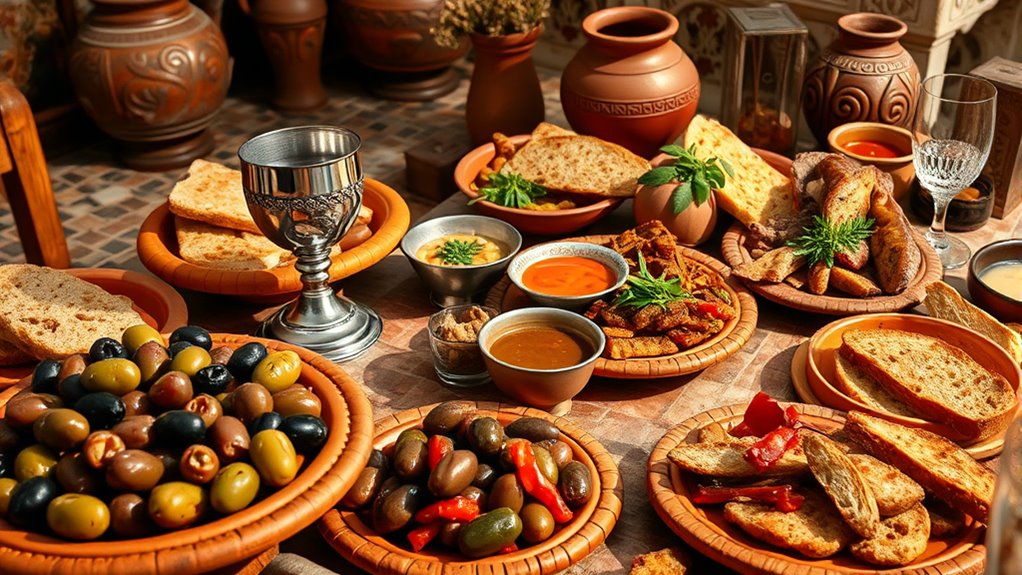Ancient Roman cuisine features a variety of flavorful recipes, from savory garum fish sauce to dishes with fresh herbs and dried meats. Romans enjoyed structured meals, often reclining during banquets to showcase social status, with etiquette guiding proper behavior. They used preservation techniques like salting, drying, and pickling to enjoy food year-round, demonstrating both practicality and culinary innovation. To discover more about their delicious recipes and fascinating eating customs, keep exploring their rich food history.
Key Takeaways
- Roman meals followed a structured sequence from appetizers to desserts, emphasizing social hierarchy and civility.
- Dining customs included reclining on couches, proper posture, and polite guest-host interactions during banquets.
- Preservation techniques like salting, drying, and fermenting allowed year-round access to diverse foods, including garum.
- Recipes often featured ingredients preserved through these methods, showcasing Roman culinary ingenuity and adaptability.
- Food culture combined social etiquette with practical innovations, reflecting values of refinement, hierarchy, and sustainability.

Ancient Roman cuisine reflects a sophisticated blend of flavors, ingredients, and culinary techniques that reveal much about their society and culture. As you explore their eating habits, you’ll notice that Roman dining etiquette played a significant role in how meals were enjoyed and socialized. For Romans, dining was more than just nourishment; it was an opportunity to display status, engage in conversation, and demonstrate good manners. You’d typically recline on a couch while eating, especially during formal banquets, which signified leisure and refinement. Proper posture and decorum mattered. It was customary to greet guests politely, and the host often directed the flow of the meal, ensuring everyone was comfortable. Sharing food was common, and dishes were served in courses, with a clear sequence from appetizers to desserts. Understanding these social cues helps you appreciate the nuances of Roman meals and the importance they placed on etiquette.
In addition to social customs, Roman food preservation techniques were essential in maintaining a steady supply of ingredients, especially given the empire’s vast reach and seasonal variations. You’d find Romans using methods like salting, drying, pickling, and fermenting to extend the shelf life of perishable foods. For example, they salted fish to make garum, a fermented fish sauce that became a staple in Roman cooking, enhancing flavor and preserving the fish for long periods. They also dried fruits, herbs, and meats to store them for future use. Pickling vegetables and fruits in vinegar or brine was another common practice. These techniques not only kept food safe but also allowed for a diverse diet throughout the year, regardless of harvests or supply disruptions. By mastering these preservation methods, Romans could enjoy a variety of flavors and ingredients even in off-season months, demonstrating their ingenuity and adaptability. The use of food preservation techniques was crucial in supporting their culinary diversity and ensuring a stable food supply.
When you consider their culinary habits, it’s clear that Roman food culture was deeply intertwined with social customs and practical innovations. Their attention to etiquette ensured meals were not only nourishing but also a reflection of social hierarchy and civility. Meanwhile, their preservation techniques laid the foundation for a vibrant, sustainable cuisine that could withstand the challenges of time and geography. These practices reveal a society that valued both tradition and innovation, shaping the rich culinary legacy we study today. Whether you’re recreating ancient recipes or simply imagining their dining rooms, understanding Roman etiquette and preservation methods helps you connect more authentically with their remarkable food culture.
Frequently Asked Questions
How Did Roman Dining Customs Vary Across Social Classes?
You’ll notice that social class disparities heavily influenced Roman dining customs. Wealthier elites often hosted lavish banquets with elaborate dishes and formal dining etiquette customs, showcasing their status. In contrast, lower classes had simpler meals, and their dining habits were more informal. As a result, your social standing affected everything from the food you ate to the way you behaved during meals, highlighting the clear divide in Roman society.
What Beverages Were Most Popular in Ancient Roman Meals?
Imagine sipping liquid gold as Roman wine flows freely at your table, the heartbeat of every feast. You’d likely indulge in Roman wine, renowned for its rich flavor, or enjoy Roman mulsum, a sweet blend of wine and honey that dances on your palate. These beverages were the stars of ancient Roman meals, elevating social gatherings and adding a touch of luxury to everyday dining.
Were There Any Specific Dietary Restrictions in Roman Society?
You should know that Roman dietary laws and societal norms shaped what you could eat. They forbade certain foods like pork for some groups and emphasized moderation. Forbidden foods included specific meats, certain fish, and some vegetables, depending on your social class and religious beliefs. These restrictions aimed to maintain purity and social order, so you’re expected to follow these dietary guidelines to stay aligned with Roman customs and religious practices.
How Did Roman Cuisine Influence Modern Mediterranean Dishes?
Roman cuisine heavily influences modern Mediterranean dishes with its use of Mediterranean flavorings like herbs, olive oil, and wine. You can see Roman culinary techniques, such as grilling and marinating, still in practice today. These methods and ingredients have shaped the flavors and cooking styles of Mediterranean countries, making their cuisine rich, vibrant, and deeply rooted in ancient Roman traditions that you enjoy in many contemporary dishes.
What Role Did Food Play in Roman Religious Rituals?
Imagine you’re at a Roman temple, livestreaming a sacrificial offering—food plays a crucial role. You’d participate in sacred rituals and temple feasts, where meals symbolized devotion and communication with gods. Food’s role extended beyond sustenance, serving as a spiritual act that reinforced community bonds and religious piety. These sacrificial offerings and feasts were essential to honoring deities and maintaining divine favor in Roman culture.
Conclusion
So, next time you complain about your dinner, remember the ancient Romans, who savored fermented fish sauces and exotic delicacies, all while meticulously cataloging their recipes. Ironically, their elaborate feasts, meant to impress, often masked simple ingredients. Maybe, in a way, their obsession with grandeur was just a grand illusion—like trying to impress with a meal that’s as complex as Roman politics. Clearly, some cravings for extravagance haven’t changed much over the centuries.









